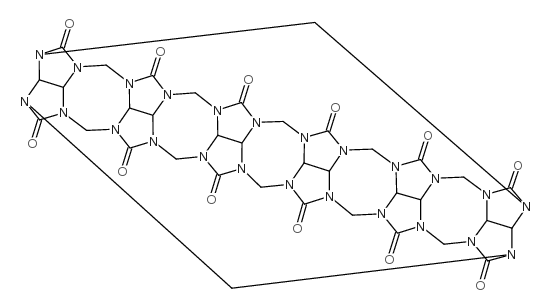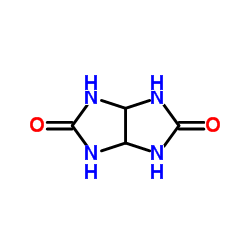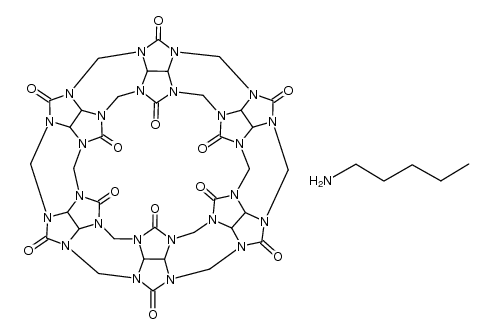cucurbituril

cucurbituril structure
|
Common Name | cucurbituril | ||
|---|---|---|---|---|
| CAS Number | 80262-44-8 | Molecular Weight | 996.82500 | |
| Density | 2.66g/cm3 | Boiling Point | N/A | |
| Molecular Formula | C36H36N24O12 | Melting Point | -470ºC | |
| MSDS | Chinese USA | Flash Point | N/A | |
Use of cucurbiturilCucurbituril is a biochemical reagent that can be used as a biological material or organic compound for life science related research. |
| Name | cucurbit[6]uril |
|---|---|
| Synonym | More Synonyms |
| Description | Cucurbituril is a biochemical reagent that can be used as a biological material or organic compound for life science related research. |
|---|---|
| Related Catalog |
| Density | 2.66g/cm3 |
|---|---|
| Melting Point | -470ºC |
| Molecular Formula | C36H36N24O12 |
| Molecular Weight | 996.82500 |
| Exact Mass | 996.29400 |
| PSA | 282.60000 |
| Appearance of Characters | solid | white |
| Index of Refraction | 2.341 |
|
Section 1: Product Identification Chemical Name:Cucurbit[6]uril (CB[6]) hydrate, 99+% CAS Registry Number:80262-44-8 Formula:C36H36N24O12.xH2O EINECS Number:none Chemical Family:macrocyclic compounds Synonym:CB[6]
Section 2: Composition and Information on Ingredients IngredientCAS NumberPercentACGIH (TWA)OSHA (PEL) Title compound80262-44-8100%no datano data Section 3: Hazards Identification Emergency Overview:Irritating to skin, eyes and respiratory tract. Primary Routes of Exposure:Ingestion, inhalation, eyes Eye Contact:Causes slight to mild irritation of the eyes. Skin Contact:Causes slight to mild irritation of the skin. Inhalation:Irritating to the nose, mucous membranes and respiratory tract. Ingestion:No information available on the physiological effects of ingestion. May be harmful if swallowed. Acute Health Affects:Irritating to skin, eyes and respiratory tract. Chronic Health Affects:No information on long-term chronic effects. NTP:No IARC:No OSHA:No SECTION 4: First Aid Measures Immediately flush the eyes with copious amounts of water for at least 10-15 minutes. A victim may need Eye Exposure: assistance in keeping their eye lids open. Get immediate medical attention. Wash the affected area with water. Remove contaminated clothes if necessary. Seek medical assistance if Skin Exposure: irritation persists. Remove the victim to fresh air. Closely monitor the victim for signs of respiratory problems, such as difficulty Inhalation: in breathing, coughing, wheezing, or pain. In such cases seek immediate medical assistance. Seek medical attention immediately. Keep the victim calm. Give the victim water (only if conscious). Induce Ingestion: vomiting only if directed by medical personnel. SECTION 5: Fire Fighting Measures Flash Point:none Autoignition Temperature:none Explosion Limits:none Extinguishing Medium:carbon dioxide, dry powder or foam If this product is involved in a fire, fire fighters should be equipped with a NIOSH approved positive pressure Special Fire Fighting Procedures: self-contained breathing apparatus and full protective clothing. Hazardous Combustion andIf involved in a fire this material may emit irritating fumes. Decomposion Products: Unusual Fire or Explosion Hazards: No unusual fire or explosion hazards. SECTION 6: Accidental Release Measures Spill and Leak Procedures:Small spills can be mixed with vermiculite or sodium carbonate and swept up. SECTION 7: Handling and Storage Handling and Storage:Store in a tightly sealed container. Keep in a cool, dry, well-ventilated area. SECTION 8: Exposure Controls and Personal Protection Eye Protection:Always wear approved safety glasses when handling a chemical substance in the laboratory. Skin Protection:Wear protective clothing and gloves. Ventilation:Handle the material in an efficient fume hood. If ventilation is not available a respirator should be worn. The use of respirators requires a Respirator Respirator: Protection Program to be in compliance with 29 CFR 1910.134. Ventilation:Handle the material in an efficient fume hood. Additional Protection:No additional protection required. SECTION 9: Physical and Chemical Properties Color and Form:white powder Molecular Weight:996.82 Melting Point:no data Boiling Point:no data Vapor Pressure:no data Specific Gravity:no data Odor:none Solubility in Water:insoluble SECTION 10: Stability and Reactivity Stability:air and moisture stable Hazardous Polymerization:no hazardous polymerization Conditions to Avoid:none Incompatibility:strong oxidizing agents Decomposition Products:carbon monoxide, carbon dioxide, nitrogen oxides, and organic fumes SECTION 11: Toxicological Information RTECS Data:No information available in the RTECS files. Carcinogenic Effects:no data Mutagenic Effects:no data Tetratogenic Effects:no data SECTION 12: Ecological Information Ecological Information:No information available SECTION 13: Disposal Considerations Disposal:Dispose of according to local, state and federal regulations. SECTION 14: Transportation Shipping Name (CFR):Non-hazardous Hazard Class (CFR):NA Additional Hazard Class (CFR):NA Packaging Group (CFR):NA UN ID Number (CFR):NA Shipping Name (IATA):Non-hazardous Hazard Class (IATA):NA Additional Hazard Class (IATA):NA Packaging Group (IATA):NA UN ID Number (IATA):NA SECTION 15: Regulatory Information TSCA:Not listed in the TSCA inventory SARA (Title 313):Not regulated under SARA 313 Second Ingredient:none SECTION 16 - ADDITIONAL INFORMATION N/A |
| Personal Protective Equipment | Eyeshields;Gloves;type N95 (US);type P1 (EN143) respirator filter |
|---|---|
| RIDADR | NONH for all modes of transport |
| WGK Germany | 3 |
|
~21% 
cucurbituril CAS#:80262-44-8 |
| Literature: Tuncel, Doenues; Steinke, Joachim H. G. Macromolecules, 2004 , vol. 37, # 2 p. 288 - 302 |
|
~% 
cucurbituril CAS#:80262-44-8 |
| Literature: US2013/195751 A1, ; Page/Page column ; |
|
~% 
cucurbituril CAS#:80262-44-8 |
| Literature: Angewandte Chemie - International Edition, , vol. 46, # 34 p. 6499 - 6501 |
| Precursor 4 | |
|---|---|
| DownStream 0 | |
|
Synthesis, processing and solid state excipient interactions of cucurbit[6]uril and its formulation into tablets for oral drug delivery.
Mol. Pharm. 7(6) , 2166-72, (2010) The synthesis, processing, and solid state excipient interactions of cucurbit[6]uril (CB[6]) and its formulation into oral tablets has been examined using a range of physical chemistry techniques. Rap... |
|
|
Unusual complex formation and chemical reaction of haloacetate anion on the exterior surface of cucurbit[6]uril in the gas phase.
J. Am. Soc. Mass Spectrom. 23(10) , 1786-93, (2012) Noncovalent interactions of cucurbit[6]uril (CB[6]) with haloacetate and halide anions are investigated in the gas phase using electrospray ionization ion mobility mass spectrometry. Strong noncovalen... |
|
|
An intelligent anticorrosion coating based on pH-responsive supramolecular nanocontainers.
Nanotechnology 23(50) , 505705, (2012) The hollow mesoporous silica nanoparticles (HMSNs), which have been used as the nanocontainers for the corrosion inhibitor, benzotriazole, were fabricated using the hard-template method. Alkaline-resp... |
| MFCD05664716 |
| Cucurbituril[6] |
| Curcubit[6]uril |
| CUCURBITURIL |
| inverted cucurbituril CB[6] |
| Cucurbit[6]uril hydrate |
| cucurbit[6]urit |
| 1H,4H,14H,17H-2,16:3,15-Dimethano-5H,6H,7H,8H,9H,10H,11H,12H,13H,18H,19H,20H,21H,22H,23H,24H,25H,26H-2,3,4a,5a,6a,7a,8a,9a,10a,11a,12a,13a,15,16,17a,18a,19a,20a,21a,22a,23a,24a,25a,26a-tetracosaazabispentaleno1,6:5,6,7cycloocta1,2,3:3,4pentaleno1,6:5,6,7c |






